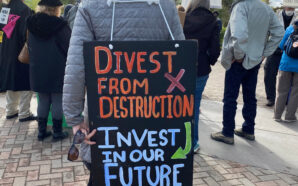Peter White
Ethnic Media Services
Across the country acts of hate are on the rise, targeting minority and historically marginalized groups and leaving lasting scars on victims, their families, and their communities. Addressing that trauma is key to healing for individuals and society.
But advocates say documenting the hate impacting diverse communities is a crucial first step.
“We have to be able to show these stories and reach as many communities as possible, because that’s where the healing will begin and it also means empowerment,” says veteran journalist and community organizer Helen Zia, founder of the Vincent Chin Institute, which commemorates the 1982 murder of Chin in Detroit.
Chin, who was Chinese American, was beaten to death by two white unemployed autoworkers who mistook him for being Japanese at a time when Japanese automakers began to make inroads into the US market. Despite numerous witnesses, the judge in the case sentenced the attackers to probation.
Zia, who spent time as an autoworker in the 1980s, says the ruling marked the birth of a “new civil rights movement” among Asian Americans.
“So these two killers actually never spent a single day in jail. But the trauma also triggered a great sense of inequality, of injustice,” Zia said, noting many Asian Americans began to draw connections to the experience of African Americans and other communities of color.
“What made a difference was a community coming together… to tell the world this is something that happens to Asian Americans. This was a terrible thing that happened to Lily Chen’s son, Vincent, and to then begin to do something about it,” said Zia, who spoke during a national press briefing organized by EMS.
Today groups like Stop AAPI Hate have taken up that cause, compiling the alarming spike in hate incidents targeting the Asian American and Pacific Islander communities since the start of the COVID-19 pandemic. In the first two years of its existence Stop AAPI Hate documented nearly 11,500 such incidents.
For victims and their families, the trauma inflicted by these attacks often leaves a lasting sense of vulnerability. In Zia’s experience it was when different communities rallied together to denounce the hate that things began to change, and that change is what promotes healing.
Zia says Vincent Chin’s mother, Lily Chin, “became like a Mamie Till for the Asian American community,” comparing the former to the bereaved mother of Emmett Till, who was tortured and lynched by racist whites in Mississippi in 1955.
“And so what happened was that she and the Asian American community were able to channel their grief through action to make a difference, and not just Asian Americans coming together, but reaching out and joining with the Black community – Black, brown, red, white – and coming together,” Zia said.
Helen Zia, author and founder of The Vincent Chin Institute, shares how Vincent Chin’s mother Lily and the Asian American community came together in the aftermath of Vincent’s murder to fight for justice.
“The state can judge, only the individual can forgive”
Still, healing does not mean forgetting.
“There is a huge percentage of people who came to America as a result of war, conflict, and genocide that occurred in their homelands,” says Julian Do, a Vietnamese refugee whose family immigrated to the U.S. after the Vietnam War.
Do is co-director of Ethnic Media Services and moderated the Friday panel, which brought together experts including Zia to look at whether and how communities can heal from the experience of hate.
“It’s been well-documented that many immigrants who have been exposed to war and imprisonment are still living with this trauma even decades later,” Do said.
One of those people is Nestor Fantini, who was a 22-year-old student at the University of Cordoba in 1976 when the Argentine military staged a coup d’état. Fantini, who today serves as editor of the Spanish-language news site Hispanic LA, was arrested and tortured but never charged with a crime. He spent four years in prison during Argentina’s “Dirty War” from 1976-1983.
“That was pure state terrorism. These victims were kidnapped. They were taken to more than 360 concentration camps and they were systematically tortured and as many as 30,000 disappeared. I mean they were executed. Prisoners were dragged and thrown from planes into the Atlantic Ocean,” Fantini said.
Eventually, more than 900 members of the junta were tried and convicted, including 26 military officers who were convicted of crimes against humanity. “The state can judge but only the individual can forgive,” Fantini said.
The offender needs to acknowledge the harm that he or she has caused, and should provide material restitution and symbolic reparations, Fantini added.
Nestor Fantini speaks on the elements of reconciliation and what reconciliation must include in order to honor human rights and make amends for harm done.
“Fix what you broke”
Reparation, not integration, was the first demand of emancipated slaves, according to James Taylor, a professor of politics and African American Studies at the University of San Francisco and a member of the San Francisco African American Reparations Committee.
“The idea of reparations goes back to Callie House,” says Taylor.
House sued the United States Treasury for $68 million dollars arguing that former slaves were owed a pension from the government. After the Civil War, a federal tax on Southern cotton was used as a retirement fund for Union soldiers. “So, she sued over the right to that taxed cotton that was Confederate cotton that black folks picked,” Taylor said. The Supreme Court ruled against the founder of the U.S. reparations movement.
That bit of history has been largely forgotten and today a new reparations movement is spreading. “But it’s just shown that time has not healed the pain that Black folk had in the 1890s. Here we are in the 2020s, still talking about the same issue,” Taylor says.
Civil rights, affirmative action, welfare are piecemeal efforts that haven’t fixed the fundamental gross economic disparity of African Americans, he says, noting that the Japanese American and Jewish communities in San Francisco are among the leading supporters of reparations.
“They know what it is to be targeted,” Taylor said, adding, “It’s not just Black America, and it’s not asking for a handout. It’s saying ‘fix what you broke’, and it’s actually a global movement.”
There are 14 countries and seven states talking about reparations now. New York, Boston, Detroit, Oakland, San Francisco, St. Paul, Detroit, Amherst and Evanston, Illinois have created funds or formed reparation task forces.
California became the first state in the country to form a statewide taskforce in 2020. New York and five other states are also considering reparation programs.
James Taylor, Professor of Politics and African American Studies, University of San Francisco, explains some of the misunderstood points of reparations and says they are key to healing the injury done to Black Americans.
“They say time heals all wounds,” said Zia. “But time is not enough. There must be action, there must be learning. We must know the past… and try to change the past so we don’t repeat it in the future.”
Download the Vincent Chin Legacy Guide to learn more about the movement born in the wake of Chin’s murder. Available in English, Spanish, Arabic, Chinese, Vietnamese, Bengali and Korean.






